Oil changes are an absolutely essential part of regular car maintenance. One of the most frustrating things that can happen when you go to change your oil is encountering an oil filter that stubbornly refuses to remove itself from the engine. If you encounter one of these inconveniences, use one of these wrenches to destroy its will to cling.
First, we’ll talk about the types of wrenches and filters out there. We’ll follow up with a list of the top ten filter wrenches you can buy. At the end, we’ll give you some tips and tricks to make your life easier, including a section where we answer the frequently asked questions.
- A Quick Guide to Filter Wrenches
- Top 10 Best Oil Filter Wrenches 2026
- 1. Best Overall Filter Wrench: Lisle Wide Range Filter Wrench
- 2. Best Strap Filter Wrench Set: OEMTOOLS 4-in-1 Swivel Oil Filter Wrench
- 3. Best Budget Filter Wrench: Tekton 5866 Pliers
- 4. Most Versatile Filter Wrenche: Neiko Two-Way Auto-Adjustable Oil Filter Wrench
- 5. Best Premium Filter Wrench: Motivx Tools 74mm Oil Filter Wrench
- 6. Best Compact Filter Wrench: Lisle Heavy Duty Strap Filter Wrench
- 7. Best Adjustable Plier Filter Wrench: Powerbuilt Self-Adjust Pliers
- 8. Best Wrench for Cartridge Filters: Motivx Tools 5pc Set
- 9. Best Inexpensive Cap Filter Wrench: Lisle 86mm End Cap Wrench Set
- 10. Best Filter Wrench Toyota/Lexus: Motivx Tools 2pc Set
- Tips, Tricks, and Extra Information
- Oil Filter FAQ
- Take the Frustration Out of Filter Changes
A Quick Guide to Filter Wrenches
Filter wrenches are tools that give you a mechanical advantage over a filter so that you can easily remove them. There are two important things to know before choosing one for your toolbox: the type of wrench that will fit in your engine bay and the type of filter you have in your car.
Types of Wrenches
There are 4 main types of wrenches, each with its own advantages, drawbacks, and ideal uses.
Plier Style Wrenches
Plier style wrenches simply function as a set of pliers. They need the most amount of room to work, but they can be used for many things that are not filters. They are perfect for tightening large pipe unions or gripping awkwardly shaped objects that you need to hold in place. They are one of the most versatile filter wrenches you can buy.
Strap Wrenches
Strap wrenches come in a variety of flavors, but they all function the same. They sometimes have a handle, but their main component is a strap or chain that tightens around the filter to help you grip it. Some are adjustable, some use a rubber strap instead of a steel strap, and older style wrenches use a chain. Other names include swivel wrenches, chain wrenches, and band wrenches.
Claw Wrenches
These go by a bunch of different names. Sometimes they are called spider wrenches, sometimes jaw wrenches, and sometimes claw wrenches. There are technically minor differences between them, but the name is mostly just a form of marketing by each manufacturer.
What they do is open up, then clamp down onto the end of a filter. The really nice thing about these tools is that they grip harder the more force you put on them. That means the more stuck the filter is, the better the tool works. You operate them with either a socket wrench or a standard open-end wrench.
Cap or Socket Style Wrenches
Cap style wrenches look like giant sockets. They fit onto the end of a socket wrench and fit over the filter’s top to grip them like a giant nut. Many modern cars have filters that are metal or plastic housings that are meant to be removed. This wrench style is absolutely crucial to have for these reusable filters because they are the only style of filter wrench that isn’t at risk of destroying the filter.
Types of Filters
There are only two styles of primary filter that you are likely to come across.
Spin-on filters have threads and spin onto either a male or female threaded spot on the engine. These are the most common types of filters. Most are disposable. You take them off, throw them away, and then install a new one.
Cartridge style filters, on the other hand, have a metal or plastic housing that contains a filter inside them. You remove the housing and then remove the filter from the housing. The new filter goes inside the housing, and the housing gets reused. Since they are better for the environment, they are slowly overtaking the popularity of spin-on.
Car-Specific Filters
Some cars, notably German cars and Toyotas, use a unique filter style that requires a special wrench. Toyota and Lexus, which is a division of Toyota, are especially notorious for this. We have their special wrench on our list here.
Filter Size
The last thing you need to know about your filter is the size. Most filter wrenches will only fit specific diameters. If you don’t know, simply search for your car plus your oil filter size on google. Chances are excellent that it will be one of the first results.
It’s all pretty simple, right? Once you know the size and type of filter you have, the most challenging part will be trying to imagine if the wrench will fit in your engine compartment or not. We’ve tried to help you out a little in our reviews, but ultimately you may have to find out by trial and error.
With all of that in mind, there should be an oil filter wrench below that will suit your needs, no matter how unique they might be.
| Product | Type | Filter Size | Filter Type | Rating |
|---|---|---|---|---|
| Lisle Wide Range Filter Wrench | Claw | 3 ⅛”-3 ⅞” | Spin-On | 5 |
| OEMTOOLS 4-in-1 Swivel Oil Filter Wrench | Strap | 2 ⅜”-4 ⅜” | Spin-On | 4.5 |
| Tekton 5866 Pliers | Pliers | 2 ¼”-4 ½” | Spin-On | 4.5 |
| Neiko Two-Way Auto-Adjustable Oil Filter Wrench | Claw | 2 ½”-4” | Spin-On | 4 |
| Motivx Tools 74mm Oil Filter Wrench | Cap | 74mm | Cartridge and Spin-On | 4 |
| Lisle Heavy Duty Strap Filter Wrench | Strap | ½”-6 ½” | Spin-On | 4 |
| Powerbuilt Self-Adjust Pliers | Plier | 2 ¼”-4 ¾” | Spin-On | 4 |
| Motivx Tools 5pc Set | Sockets | 24mm-36mm | Cartridge | 4 |
| Lisle 86mm End Cap Wrench Set | Cap | 3 ⅜” (86mm) | Spin-On | 3.5 |
| Motivx Tools 2pc Set | Cap | Toyota/Lexus Specialized | Toyota/Lexus Specialized | 3.5 |
Top 10 Best Oil Filter Wrenches 2026
1. Best Overall Filter Wrench: Lisle Wide Range Filter Wrench
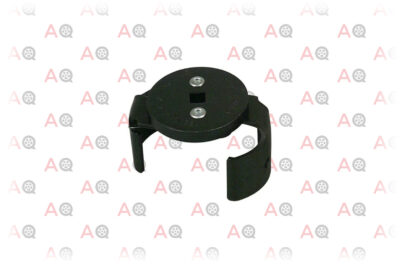
Editor’s Rating:
Quick Facts:
- Type: Claw
- Filter Size: 3 ⅛”-3 ⅞”
- Filter Type: Spin-On
How It Is Used
First, you slip it over the end of the filter. Then you turn it until it tightens down onto the end and starts to grip it. Finally, insert a ⅜” drive socket wrench, or wrench with an extension, into the claw and break it loose. It’s that simple.
There’s a lot of reasons that this style of wrench is invaluable. First, it’s probably your best chance to break a stubborn filter loose. Since they get tighter as you tighten, you will not risk losing your grip on the filter.
Second, they are very compact and can slip onto a filter in any position. All you need is to be able to get some kind of socket wrench, extension, and/or universal combination onto the end, and you are good to go.
Verdict
It’s rare that a specialized tool is cheap and works great. That’s what this claw style wrench is, though. It will take off a stubborn filter with minimal work.
That being said, there are a few reasons you would want to go with a different tool. The first is that you have a cartridge filter. The jaws will clamp onto the housing and damage it. If you have a cartridge filter or you want to protect the filter, invest in a set of tools like this OEMTOOLS set.
The other reason you might get a different tool is that you can only get to your oil filter from the side. It’s a bit rare, but some motors have the filter mounted high up in the engine bay, and the only way to get at them is to reach up with some pliers and twist them off. This thing is very inexpensive, though, so it doesn’t cost much to try it out if you aren’t sure.
Pros
- Inexpensive
- Good for hard to remove filters
- Can fit into tight spots
Cons
- Might destroy the filter
- You have to be able to get to the end of the filter
2. Best Strap Filter Wrench Set: OEMTOOLS 4-in-1 Swivel Oil Filter Wrench
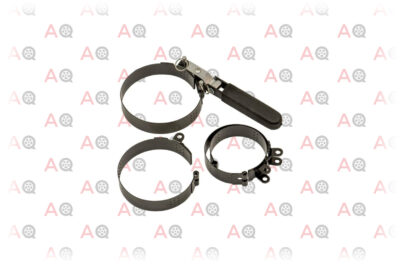
Editor’s Rating:
Quick Facts:
- Type: Strap
- Filter Size: 2 ⅜”-4 ⅜”
- Filter Type: Spin-On
How It Is Used
Strap wrenches like this are probably the easiest to use tools on this list. They are stand-alone tools, so you don’t need a socket wrench or anything else to use them. They are also really intuitive to use. It looks like a lasso. Lasso the filter and give it a twist.
The nicest thing about strap or band wrenches is that they work for 90% of filters. Chances are you can slip them onto a filter in any position, at any spot on the filter, and they won’t hurt metal housings.
The only downside is that they only fit a small range of diameters, but this set gets around that issue by including four different sizes all in one kit.
Verdict
Most of the time, a strap wrench is going to be the tool you reach for when you can’t spin the filter off by hand. They can slip, which is why having a claw style wrench like this Lisle one is a great backup. The strap won’t damage the filter, though, so if you are worried about a mess, it’s better to try the strap first.
The only issue with them is that you have to have room on one side of the filter for the handle. Some cars have the filter pretty firmly hidden; the late 90s JDM cars were notorious for trapping the oil filters between the block and the exhaust. That’s where cap style wrenches reign supreme, since all you have to do is be able to see the end of the filter.
Pros
- Fit most common filters
- Set includes a variety of sizes
- Not destructive
Cons
- Needs room for the handle
- Not good for filters that are really stuck
3. Best Budget Filter Wrench: Tekton 5866 Pliers
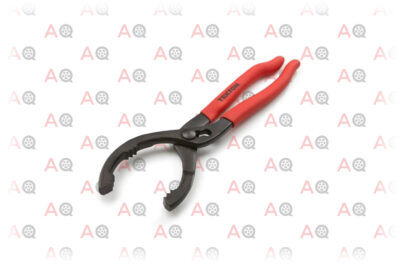
Editor’s Rating:
Quick Facts:
- Type: Pliers
- Filter Size: 2 ¼”-4 ½”
- Filter Type: Spin-On
How It Is Used
You grab the filter with the jaws and twist. The only reason we say the band wrenches are easier to use is that the pliers take a bit of coordination to use. You have to make sure they are adjusted to the right diameter, and they need a lot of room to work.
Since you will often only have room for one-handed operation, it will take some practice to get a good grip on the filter with the pliers. It’s easy to over squeeze and distort the filter, which only ups the amount of practice you need to do the job frustration-free.
Verdict
Filter pliers are just one of those tools that everyone should own. They are not the best filter wrench because they are unwieldy and need a lot of space, but they are useful for a lot more than just filters. Any large diameter pipe or awkwardly shaped engine part can be gripped by these pliers.
In our opinion, it’s best to have a set of these as a backup for your main wrench. You will probably only use them once or twice a year, but they are absolutely invaluable when you do need them.
They are inexpensive, too, so it’s easy to grab a pair and throw it in a drawer to forget about. Then, one day, you will be searching for a tool to do a task you never thought you’d have to do. You’ll stumble across them, and your day will be saved.
Pros
- Inexpensive
- Useful for more than just filters
- Good amount of grip
Cons
- You need a bit of coordination to use them
- They need a lot of space to work well
4. Most Versatile Filter Wrenche: Neiko Two-Way Auto-Adjustable Oil Filter Wrench
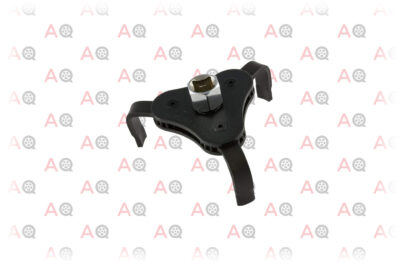
Editor’s Rating:
Quick Facts:
- Type: Claw
- Filter Size: 2 ½”-4”
- Filter Type: Spin-On
How It Is Used
This adjustable claw wrench looks complicated, but it’s really no different in operation from the Lisle wrench. It just has three points of contact instead of only two. You twist it onto the end of the filter until it grips, and as you loosen the filter, the fingers get tighter.
This wrench’s nice advantage over the Lisle is that it has a big nut protruding out of it. That way, you can operate it with either an open wrench, crescent wrench, or socket wrench—or whatever you have handy.
Verdict
It’s really hard to say whether the Lisle or the Neiko is the better wrench. The Lisle can handle more torque, but you can get a wrench on the Neiko. Ultimately it’s the quality that pushes the Lisle to the top, but that doesn’t mean the Neiko is a bad tool at all.
Just be aware that it suffers from all the drawbacks of a claw style wrench. It can destroy filters. In fact, because of the small fingers, you run the risk of punching through the sides of the filter and leaking oil everywhere. If you value the fact that you don’t need a socket wrench to use it, though, it’s a great buy.
Pros
- Good for stuck filters
- Doesn’t need a socket wrench to be used
- Can fit in tight spots
- Very versatile
Cons
- Quality could be better
- Risk of destroying the filter is high
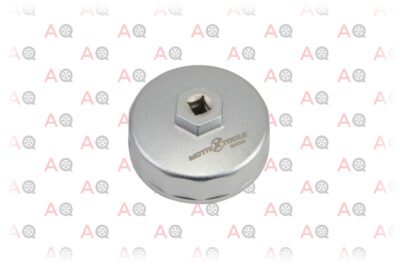
Editor’s Rating:
Quick Facts:
- Type: Cap
- Filter Size: 74mm
- Filter Type: Cartridge and Spin-On
How It Is Used
You slip the cap over the top of the filter or housing. Then insert a ⅜” drive socket wrench into the square hole in the top, or use an open wrench on the hex nut, and give it a twist. That’s all there is to it; these are basically just really big sockets.
The downside is that they only fit the exact size they are built for, so if you have an 84mm filter, this one won’t work. The good news is that 74mm is one of the most common sizes out there, so you probably won’t have an issue.
Verdict
There are two styles of cartridge filter housings. One style has a big bolt through the center, and that style needs a big socket set like thisMotivx set we recommend. This style of tool is for everything else, and even a lot of spin-on filters. You can use it to apply a lot of force to a cap without damaging it, so cars that have been neglected for years won’t be an issue when you try and change the filter.
This particular Motivx tool is on the expensive side. The entire tool basically amounts to a single large socket. It’s built to last a really long time, though, and stand up to being abused in a shop. If you only plan on doing an oil change every so often, a cheaper cap wrench like this Lisle one we recommend will do fine.
Pros
- Can handle a lot of torque
- Won’t damage the housing
- High-quality
Cons
- Expensive for a single purpose tool
- Only fits one size
6. Best Compact Filter Wrench: Lisle Heavy Duty Strap Filter Wrench

Editor’s Rating:
Quick Facts:
- Type: Strap
- Filter Size: ½”-6 ½”
- Filter Type: Spin-On
How It Is Used
You pull the strap around the filter and feed it through the slot like you are fitting a belt onto the filter. Then you put a ⅜ drive or ½ drive socket wrench with an extension into the buckle. As you put torque onto the buckle, the strap will tighten and apply the torque to the filter.
It does take a bit of practice to get it right. You need to get the buckle positioned right and make sure that you leave the drive end you need showing. What makes band wrenches with an attached handle, like the ones we recommend here, so nice is that you don’t have to use another wrench or guess at which way it’s facing or anything like that.
Traditional strap wrenches are a lot more compact and versatile, though. They also don’t have any parts that can break, unlike wrenches with handles or jaw wrenches that have a lot of moving parts.
Verdict
If you work on tractors or any other heavy-duty piece of equipment, a strap wrench like this is a must-have. That’s because they can fit on the big filters that big vehicles use. They are also easy to carry out into the field since they roll up and fit in your pocket.
Most of the downsides come from being a bit more complicated to use than most filter wrenches. They also take a lot longer to use. That’s probably not an issue for most people.
However, if you are working in a shop and building your tool kit, be aware that you’ll be spending a lot longer rolling up the strap every time than someone else would spend just using a jaw style wrench to pop the filters off.
Pros
- Compact
- Can fit onto a very large range of filters
- Indestructible
Cons
- Somewhat difficult to use
7. Best Adjustable Plier Filter Wrench: Powerbuilt Self-Adjust Pliers
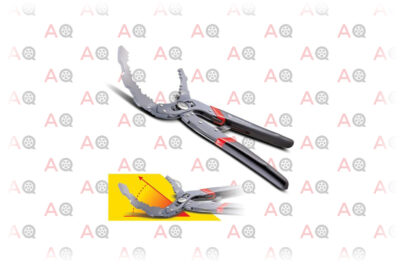
Editor’s Rating:
Quick Facts:
- Type: Plier
- Filter Size: 2 ¼”-4 ¾”
- Filter Type: Spin-On
How It Is Used
It’s just like the other plier style tool we recommend, it’s just a little easier to use since it adjusts automatically. That makes it really nice for one-handed operation since you don’t have to fumble with getting the channels and pins lined up. You just reach up and grab the filter. The automatic adjustment will allow the jaws to lock in place and apply maximum grip to the filter.
You still need a lot of space, though, and you will still damage the filter if you squeeze too hard.
Verdict
In our review of the other plier style wrench on our list, we said that everyone should own one. That’s because they are great for many things beyond just removing filters, and this is no exception. You can use it for pipes, big nuts, old tires, and really anything else that is too awkward to grip with a normal pair of channel locks.
The question is, then, should you get the cheaper set or the more expensive set here. It basically comes down to how often you think you’ll need them. The Powerbuilt tool here is a bit higher quality, and it auto-adjusts, making it easier to use. If you think you’ll need it more than a few times a year, splurge on this one.
Pros
- Self-adjusting
- Good quality
- Easy to use
Cons
- Needs a lot of room to work
- Can destroy the filter
8. Best Wrench for Cartridge Filters: Motivx Tools 5pc Set
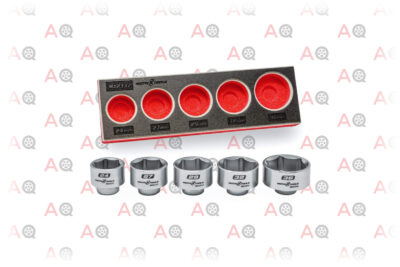
Editor’s Rating:
Quick Facts:
- Type: Sockets
- Filter Size: 24mm-36mm
- Filter Type: Cartridge
How It Is Used
These are just big sockets. They are built for filter housings held together with standard hex bolts, and they work exactly like any other socket wrench. The really nice thing about this set, and the reason you would want it over a standard set of sockets, is that they are very high-quality and represent the most common sizes for filters.
It’s very hard to find a low profile 36mm socket, and it’s nearly impossible to find one in ⅜” drive. By having a nice, complete set, you’ll always know that you will have those specific sizes on hand and ready to work on your vehicle.
Verdict
If you have a bolted cartridge-style filter on your car, a set like this is invaluable. There are bigger kits for sale around, and there are certainly cheaper sets, but Motivx makes high-quality tools, and this kit includes the most common sizes.
Just be aware that these are not the same as a cap style filter wrench. An oil filter typically has a diameter of 76mm or more, whereas these sockets only go up to 36mm. If you are looking for a socket that will fit onto the filter and apply torque directly to the housing, we have another Motivx tool on our list for that.
Pros
- High-quality
- Includes sockets that are otherwise hard to find
- Set fits a variety of sizes
Cons
- A little expensive
- Only good for a certain type of filter system
9. Best Inexpensive Cap Filter Wrench: Lisle 86mm End Cap Wrench Set
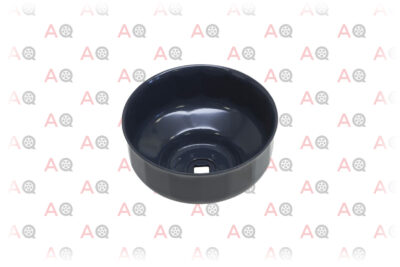
Editor’s Rating:
Quick Facts:
- Type: Cap
- Filter Size: 3 ⅜” (86mm)
- Filter Type: Spin-On
How It Is Used
All you have to do is slip this cap over your 86mm filter, put your socket wrench onto it, and unscrew the filter. There’s nothing more to it.
There are two things that separate this Lisle cap wrench from the Motivx wrench we recommend. The first is that this one is 86mm instead of 74mm. 86mm is probably the second most common size for a filter, so chances are one or the other will work for your vehicle.
The second thing is that this Lisle wrench does not have a nut that you can slip an open wrench onto. You must use a ⅜” drive socket wrench.
Verdict
This cap wrench is cheap and easy to use. It’s not as high-quality as other wrenches, and it’s not as versatile, but if you have an 86mm filter, then you don’t need anything else.
Pros
- Cheap
- Non-destructive
- Easy to use
Cons
- Not very high quality
- Only fits one size of filter
10. Best Filter Wrench Toyota/Lexus: Motivx Tools 2pc Set
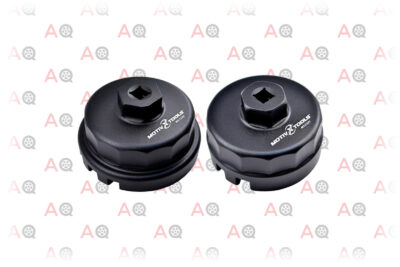
Editor’s Rating:
Quick Facts:
- Type: Cap
- Filter Size: Toyota/Lexus Specialized
- Filter Type: Toyota/Lexus Specialized
How It Is Used
These wrenches work exactly like the other Motivx cap wrench we have on our list. You slip them over the end and then use a ⅜” socket wrench or any open wrench to unscrew the filter.
The most important thing to know about these Motivx tools is that they are specifically built for Toyota and Lexus vehicles. If you own a newer Toyota or Lexus, you are pretty much forced into buying one of these tools.
Verdict
There are a lot of other tool manufacturers that make these same Toyota specialty tools. Many are less expensive, and many offer either the large or the small on their own. We recommend the Motivx tools because they are very high quality, and you can get the set if you are not sure which size you need.
Pros
- High-quality
- Easy to use
- Required if you own a newer Toyota/Lexus
Cons
- Only good for very specific scenarios
- A little expensive
Tips, Tricks, and Extra Information
Down here in this section, we’ve included expert tips on the oil change procedure that you can use to make your next oil filter replacement an absolute breeze.
General Oil Filter Replacement Tips
The following list is a list of things you can do to make your life easier during your next oil change.
Prepare First
Clean the area before you start. Simply spraying the old filter down with some degreaser and wiping with a rag is sufficient. That will keep your tools clean and lower the chance of contamination.
Always make sure new spin-on oil filters are half-filled with new oil before installation. If you don’t, there is a small chance that the engine can be without oil for a brief moment.
If the filter or housing has a rubber seal, take a moment and apply a thin coat of new oil to the rubber seal. Simply wiping it on with your finger is good enough, and it will prevent cracking.
Work Carefully
Don’t over-tighten the filter. Canister style filter housings will have an official torque spec that you can look up. Spin-on filters should be hand-tight. In theory, you should be able to take off a spin-on filter without a tool, and that starts with not over-tightening it to begin with.
Only use as much pressure as necessary, since damaging a filter can result in oil flowing freely onto your floor or your face. One good thing about jaw or spider style filter tools is that the filter should break loose before you can damage it too badly.
Clean up After Yourself
When working with a canister style filter, make sure you have a rag or nearby surface to support all the parts. Disposable filters can just be tossed directly into the trash after draining.
Other Helpful Oil Change Tools
There are a variety of other tools that can be really helpful if you are changing your oil, and we have recommendations for all of them.
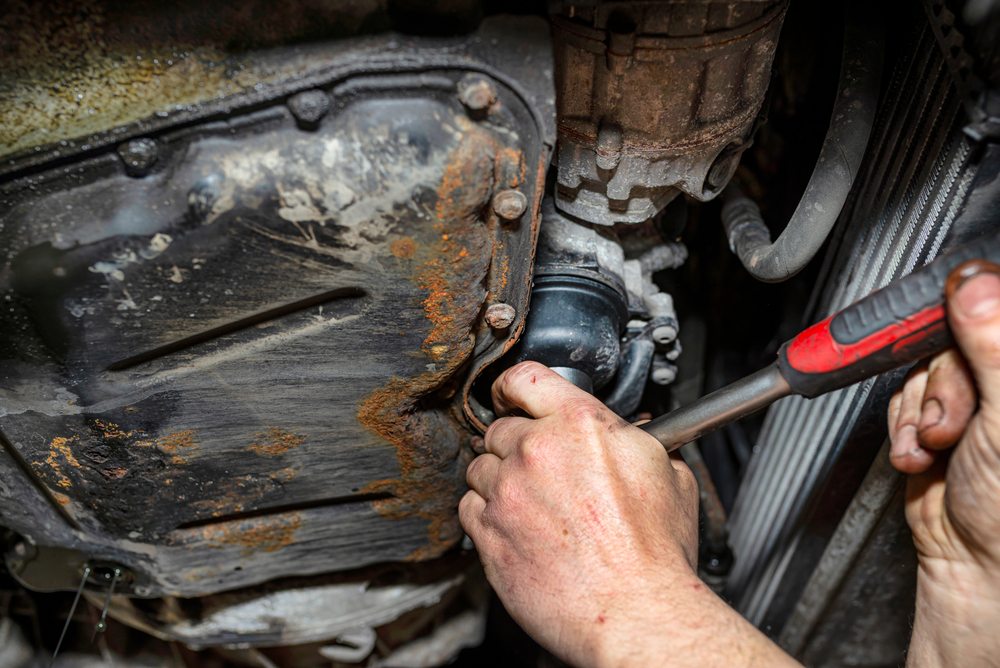
- An oil extractor can make the entire oil change process a lot cleaner and easier.
- Many of the filter wrenches we recommend require a socket wrench, and it’s good to have a complete set just in case you have to remove parts that are in your way.
- Engine degreaser for wiping down tools after you use them and cleaning the area before starting. Gunk brand is a favorite of ours.
- A drain pan is great for keeping your floor clean and having an easy way to transport the used oil to a proper disposal site.
Changing a Filter Without a Wrench
If you ask us, we will say that you should have a filter wrench for your car if you plan on working on it. However, strictly speaking, you don’t need one to do an oil change. Ideally, the filter is only hand tight, so they should be easy to spin on and off.
There are a ton of reasons they can be stuck, though. Drive through lube shops are notorious for over-torquing the filters on. Hot engines or engines that experience excessive vibrations can also cause an oil filter to be difficult to remove.
The Screwdriver Method
If you can’t remove the filter by hand and don’t have the right tool, there is one last resort method for removing a stuck filter. It’s known as the screwdriver method. It involves using a screwdriver to stab the filter so you can use the screwdriver as a handle. It’s messy, might tear the filter apart, and may damage other parts of your engine.
Here it is in action on YouTube, but we do suggest simply buying one of the inexpensive tools we recommend instead.
Oil Filter FAQ
How Long Does an Oil Filter Last?
There’s no easy answer to this question. Engines that have to work harder, or have precision components like turbos, will go through oil filters faster than those that don’t. It also depends on the size, type, and quality of the filter. The best thing to do is to make sure you follow the maintenance schedule of your vehicle.
Do You Really Need a Filter Wrench?
No. We go over it here, but you can use a screwdriver if things get too tough. It’s not recommended, especially when a filter wrench is a fairly inexpensive tool.
How Often Should You Replace Your Oil Filter?
The general rule is that you should replace your filter every other oil change. Usually, you will want to replace your oil every 3 months, which means you will replace your oil filter about twice a year. Be sure to check your vehicle’s specifications, though: you may be able to wait much longer between services.
Are Canister Filters Better Than Disposable Filters?
The short answer is “kind of.” They are better for the environment (you can read about that here) and they can offer better performance in some circumstances. They are harder to change, and they require specialized housings that spin-on filters don’t, however, so it’s best to leave the decision up to the people who designed the engine.
Take the Frustration Out of Filter Changes
No matter what the make and model of the car you drive is, there is a filter wrench for you. Grab one, and you can reclaim all the time you would normally spend fighting with a slippery oil filter. Just don’t be surprised if all your friends need to borrow it after they drip oil up to your door while holding a screwdriver.


